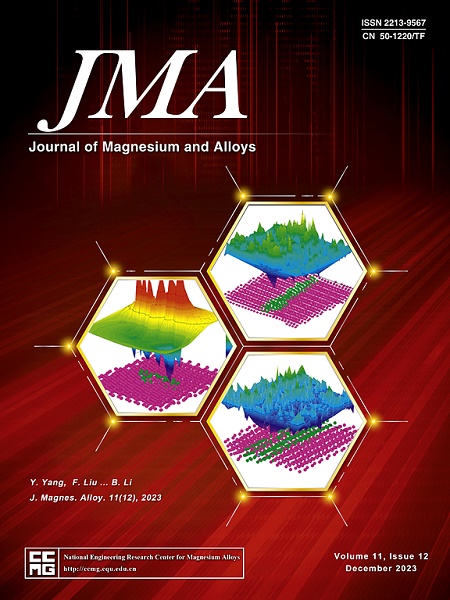通过引入椭圆形纹理分布,开发具有高温室温成型性的新型镁 2Zn 3Li 1Gd 合金薄板
IF 15.8
1区 材料科学
Q1 METALLURGY & METALLURGICAL ENGINEERING
引用次数: 0
摘要
本文章由计算机程序翻译,如有差异,请以英文原文为准。

Developing a novel Mg2Zn3Li1Gd alloy sheet with high room-temperature formability by introducing an elliptical texture distribution
In recent years, modification of texture distribution has been considered a valid approach to improve the room-temperature (RT) formability of magnesium (Mg) alloys. In this study, a novel Mg![]() 2Zn
2Zn![]() 3Li
3Li![]() 1Gd alloy sheet with weak elliptical-texture was fabricated by cold rolling and subsequent annealing, and it showed an excellent Erichsen (IE) value near 7.1 mm. Both quasi-in-situ electron backscatter diffraction (EBSD) and transmission electron microscopy (TEM) analysis indicate that considerable basal and pyramidal dislocations can be activated in the cold rolling process. During annealing, these dislocations can induce nucleation and then cause preferential misorientation relationships around 〈uvt0〉 concerning the nuclei and parent grains, which can facilitate the formation of elliptical texture. Furthermore, the particle-stimulated nucleation (PSN) mechanism and the co-segregation of Zn and Gd at grain boundaries (GB) further weak texture intensity. Finally, the mechanical properties of the Mg
1Gd alloy sheet with weak elliptical-texture was fabricated by cold rolling and subsequent annealing, and it showed an excellent Erichsen (IE) value near 7.1 mm. Both quasi-in-situ electron backscatter diffraction (EBSD) and transmission electron microscopy (TEM) analysis indicate that considerable basal and pyramidal dislocations can be activated in the cold rolling process. During annealing, these dislocations can induce nucleation and then cause preferential misorientation relationships around 〈uvt0〉 concerning the nuclei and parent grains, which can facilitate the formation of elliptical texture. Furthermore, the particle-stimulated nucleation (PSN) mechanism and the co-segregation of Zn and Gd at grain boundaries (GB) further weak texture intensity. Finally, the mechanical properties of the Mg![]() 2Zn
2Zn![]() 3Li
3Li![]() 1Gd alloy sheet are significantly improved.
1Gd alloy sheet are significantly improved.
求助全文
通过发布文献求助,成功后即可免费获取论文全文。
去求助
来源期刊

Journal of Magnesium and Alloys
Engineering-Mechanics of Materials
CiteScore
20.20
自引率
14.80%
发文量
52
审稿时长
59 days
期刊介绍:
The Journal of Magnesium and Alloys serves as a global platform for both theoretical and experimental studies in magnesium science and engineering. It welcomes submissions investigating various scientific and engineering factors impacting the metallurgy, processing, microstructure, properties, and applications of magnesium and alloys. The journal covers all aspects of magnesium and alloy research, including raw materials, alloy casting, extrusion and deformation, corrosion and surface treatment, joining and machining, simulation and modeling, microstructure evolution and mechanical properties, new alloy development, magnesium-based composites, bio-materials and energy materials, applications, and recycling.
 求助内容:
求助内容: 应助结果提醒方式:
应助结果提醒方式:


